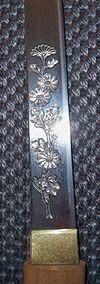Horimono (彫り物, 彫物, literally carving, engraving), also known as chōkoku (彫刻, "sculpture"), are the engraved images in the blade of a nihonto (日本刀) Japanese sword, which may include katana or tantō blades.[1] The artist is called a chōkokushi (彫刻師), or a horimonoshi (彫物師, "engraver"). There are a variety of designs, which include tsume (爪) "claws", kusa kurikara (草倶利伽羅) (Arabesque style), Munenagabori (created in Munenaga), renge (蓮華) (lotus blossom) and rendai (蓮台)(lotus pedastal), fruit, dragons, and many others.
Tattooing
Horimono can also refer to the practice of traditional tattooing in Japanese culture; while irezumi usually refers to any tattooing (and often has negative connotations in Japan), "horimono" is usually used to describe full-body tattoos done in the traditional style.[2] In some cases, these tattoos can cover the whole body, including the arms and legs.
References
- ^ "Glossary". Archived from the original on 8 November 2006. Retrieved 24 October 2006.
- ^ "History of Irezumi/Horimono". 3 April 2019.
External links
- Image of blades with Horimono
- Image of Horimono Blade
- So-ken Kin-ko To-shin Cho-koku Katayama Shigetsune
- Modern engraved blades pictures
